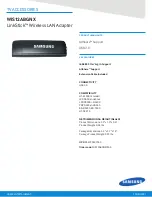
274 • ETHERNET
Network communication
Modular I/O System
ETHERNET TCP/IP
Key data
Address range of the
Possible number of
subnetwork
networks
Subscribers per
network
Class A
1.XXX.XXX.XXX -
126.XXX.XXX.XXX
127
(2
7
)
Ca. 16 Million
(2
24
)
Class B
128.000.XXX.XXX -
191.255.XXX.XXX
Ca. 16 thousand
(2
14
)
Ca 65 thousand
(2
16
)
Class C
192.000.000.XXX -
223.255.255.XXX
Ca. 2 million
(2
21
)
254
(2
8
)
Each WAGO ETHERNET fieldbus coupler/controller can be easily assigned
an IP address via the implemented BootP protocol. For small internal networks
we recommend selecting a network address from Class C.
Attention
Never set all bits to equal 0 or 1 in one byte (byte = 0 or 255). These are re-
served for special functions and may not be allocated. I.e. the address
10.0.10.10 may not be used due to the 0 in the second byte.
If a network is to be directly connected to the Internet, only registered, inter-
nationally unique IP addresses allocated by a central registration service may
be used. These are available i.e. from InterNIC (International Network Infor-
mation Center).
Attention
Direct connection to the Internet should only be performed by an authorized
network administrator and is therefore not described in this manual.
Subnets
To allow routing within large networks a convention was introduced in the
specification RFC 950. Part of the Internet address, the subscriber ID is di-
vided up again into a subnetwork number and the station number of the node.
With the aid of the network number it is possible to branch into internal sub-
networks within the partial network, but the entire network is physically con-
nected together. The size and position of the subnetwork ID are not defined;
however, the size is dependent upon the number of subnets to be addressed
and the number of subscribers per subnet.
1
8
16
24
32
1
0
Net-ID
Subnet-ID
Host-ID
Fig. 5-10: Class B address with field for subnetwork ID
















































